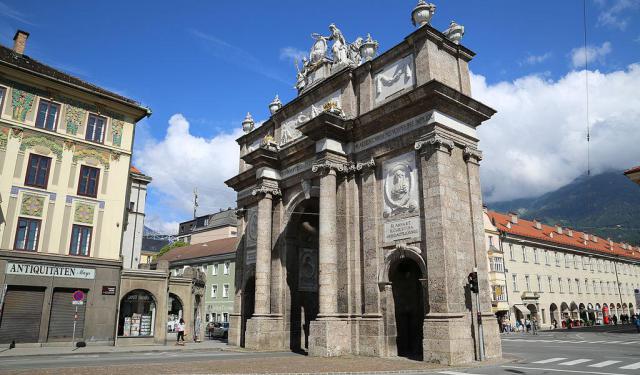Hofkirche (Court Church), Innsbruck (must see)
Holy Roman Emperor Maximilion I (1459-1519) had become obsessed with the reality of death. He carried his coffin with him in his travels. A ruler who had pursued fame and glory with gusto all his life now thought mostly of his tomb. He was buried in the Saint George castle chapel in Vienna. His son, Charles V, and his grandson, Ferdinand I, financed the tomb project.
There was a catch. There wasn't enough room in the Saint George castle chapel for Maximilion and the tomb. Something had to give. No problem. Ferdinand built a monastery and tomb in Innsbruck, over 300 miles away. Maximilion stayed in Vienna.
The Innsbruck building was named Court Church ("Hofkirche" in German). The Court Church is next to the Imperial Palace (Hofburg). The design of the church is by Andrea Crivelli of Trento. It follows the plan of a German "hall church."
It has three naves, both round and pointed arch windows, and a hip roof. There is a blend of Renaissance designs and German Gothic styles. The portal is Renaissance, carved by Hieronymus de Longhi and Anton de Bol.
Inside there are galleries and thin red marble colonettes with white capitals. The vault is in 17th-century Baroque style. The high altar, designed by court architect Nikolas Pacassi, dates from 1755. There are statues of Francis of Assisi and Teresa of Avila by Balthasar Moll and the world-famous Renaissance organ is by Jorg Ebert.
The Siver Chapel (a side chapel) has an altar to Mary made from silver, three elephant tusks, and 300 kilos of ebony. The chapel holds the tombs of Ferdinand II and his spouse, Philippine Welser.
In the center of the nave is the black marble Mannerist cenotaph of Emperor Maximilion. It was completed in 1572. The final touches of the kneeling Maximilion, the four virtues, and the iron grille were done by 1584.
Twenty-four bas-reliefs depict the events of Maximilion's life. There are 28 bronze statues of Habsburg emperors and ancestors. Andreas Hofer, the national hero of Tyrol, is also buried in the church.
There was a catch. There wasn't enough room in the Saint George castle chapel for Maximilion and the tomb. Something had to give. No problem. Ferdinand built a monastery and tomb in Innsbruck, over 300 miles away. Maximilion stayed in Vienna.
The Innsbruck building was named Court Church ("Hofkirche" in German). The Court Church is next to the Imperial Palace (Hofburg). The design of the church is by Andrea Crivelli of Trento. It follows the plan of a German "hall church."
It has three naves, both round and pointed arch windows, and a hip roof. There is a blend of Renaissance designs and German Gothic styles. The portal is Renaissance, carved by Hieronymus de Longhi and Anton de Bol.
Inside there are galleries and thin red marble colonettes with white capitals. The vault is in 17th-century Baroque style. The high altar, designed by court architect Nikolas Pacassi, dates from 1755. There are statues of Francis of Assisi and Teresa of Avila by Balthasar Moll and the world-famous Renaissance organ is by Jorg Ebert.
The Siver Chapel (a side chapel) has an altar to Mary made from silver, three elephant tusks, and 300 kilos of ebony. The chapel holds the tombs of Ferdinand II and his spouse, Philippine Welser.
In the center of the nave is the black marble Mannerist cenotaph of Emperor Maximilion. It was completed in 1572. The final touches of the kneeling Maximilion, the four virtues, and the iron grille were done by 1584.
Twenty-four bas-reliefs depict the events of Maximilion's life. There are 28 bronze statues of Habsburg emperors and ancestors. Andreas Hofer, the national hero of Tyrol, is also buried in the church.
Want to visit this sight? Check out these Self-Guided Walking Tours in Innsbruck. Alternatively, you can download the mobile app "GPSmyCity: Walks in 1K+ Cities" from Apple App Store or Google Play Store. The app turns your mobile device to a personal tour guide and it works offline, so no data plan is needed when traveling abroad.
Hofkirche (Court Church) on Map
Sight Name: Hofkirche (Court Church)
Sight Location: Innsbruck, Austria (See walking tours in Innsbruck)
Sight Type: Religious
Guide(s) Containing This Sight:
Sight Location: Innsbruck, Austria (See walking tours in Innsbruck)
Sight Type: Religious
Guide(s) Containing This Sight:
Walking Tours in Innsbruck, Austria
Create Your Own Walk in Innsbruck
Creating your own self-guided walk in Innsbruck is easy and fun. Choose the city attractions that you want to see and a walk route map will be created just for you. You can even set your hotel as the start point of the walk.
Innsbruck's Architectural Jewels
Coveted by empires, republics and ruling dynasties over the centuries, Innsbruck has been a living treasure house of history and culture. Undoubtedly this is one of Europe's most idyllic cities, nestled amid the craggy peaks in the heart of the Austrian Alps. Innsbruck equally scores as an Alpine playground and a showcase for Hapsburg imperial heritage, and is famous for its ancient,... view more
Tour Duration: 1 Hour(s)
Travel Distance: 1.4 Km or 0.9 Miles
Tour Duration: 1 Hour(s)
Travel Distance: 1.4 Km or 0.9 Miles
Innsbruck Introduction Walking Tour
Innsbruck is the capital of Tyrol, Austria. It lies in a broad valley on the river Inn, not far from the Brenner Pass. The name "Innsbruck" means "Bridge over the Inn." In the 4th century Romans established a military outpost there, calling it "Bridge over the Oeni" ("Oeni Pontum" in Latin).
In 1180 the Counts of Andechs took over the town. The Brenner... view more
Tour Duration: 1 Hour(s)
Travel Distance: 1.8 Km or 1.1 Miles
In 1180 the Counts of Andechs took over the town. The Brenner... view more
Tour Duration: 1 Hour(s)
Travel Distance: 1.8 Km or 1.1 Miles





